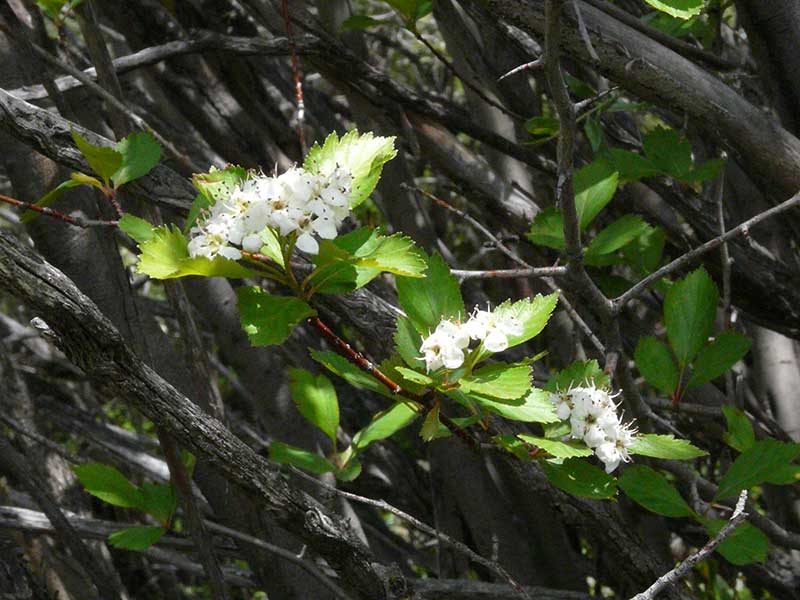Crataegus douglasii / black hawthorn
- slightly thorny shrub or small tree, to 30 feet
- often forms thickets
- broad leaves with toothed edges, clumped at ends of branches
- clumps of white, globe-shaped flowers in spring; prominent black anthers
- clumps of black “berries” in autumn
Also known as: Douglas’ thornapple, western thorn apple
Synonym: Crataegus columbiana
And the small birds cry again;
And the hawthorn hedge puts forth its buds
And my heart puts forth its pain.
* * * * *
The black hawthorn is a thorny, highly branched shrub or small tree. It ranges in size from about 6 to 30 feet. Seen from a bit of a distance, it is compact and rounded. It often forms a thicket. Seen more close-up, the twigs are reddish with rather widely spaced, inch-or-so long, quite strong thorns.
Looking at the shrub more closely, the leaves are generally 1.5 to 2.5 inches long, broad, and serrated (toothed) around the tips. They are heavily concentrated at the ends of branches, just below the flowering tips.
The flowers are clumped together and showy. The stamens are prominent. In this case, the white, globe-shaped flowers occur in dense, terminal clusters, i.e. in bunches at the ends of thin branches. From a distance or in photos, the flowers may appear covered with black dots. Look closer and you will see that these are the anthers… the pollen containing bits at the tips of the stamens. Black hawthorn has 10 of these per flower.
The flowers appear in early spring and flowering may continue through early summer. By the end of summer, they have been replaced by clumps of black-ish, smooth fruits – haws – each about a half inch in diameter. These fruits, sometimes called “berries”, are actually pomes, and are therefore structured like apples. Each fruit has 4 – 5 seeds.
Black hawthorn tolerates a wide variety of soil, light and moisture conditions although it is predominantly an understory species. It is usually found on moist sites in open areas, forest edges and along streams. It is, however, also found on steep, uncultivated slopes of any exposure, including dry southern aspects so long as moisture levels are sufficient.
Interesting bits – Black hawthorn is a pretty cool species for a number of reasons:
- Its growth is characterized by thick, intricate branching. The resultant impenetrable tangle of a hawthorn thicket provides good cover for birds and small mammals.
- Temperatures in a hawthorn thicket are lower than surrounding areas because of the density of the branches and leaves. Even the soil under a hawthorn thicket is cooler than adjacent soils in full sun or under lighter shade.
- The flexible stems are very good at withstanding avalanche pressure.
- If the stems are cut, burned or otherwise removed, resprouting from the stem and regrowth from root suckers can be prolific… again a positive feature for small critters.
- The fruits are edible and an important winter food source for browsers.
- As for “uses”, because the stems are rather short and not all that thick, there are few. However, it has been used for tool handles and some small tools because the wood is dense and strong.
Beyond the biological, the British hawthorn (or whitethorn, C. monogyna) in Celtic folklore is a magical and most sacred of trees, symbolizing love, hope, protection. Partly because it is the tree under which the fairies live and they are its guardians, it must be treated with great respect and care. Cutting a lone hawthorn is particularly bad form and risks the fairies’ ire. However, politely collecting Hawthorn sprigs and flowers is allowed, especially by brides. Wearing hawthorn blossoms in their hair or including them in their bouquet symbolizes a union of love.
If you have a hawthorn on your land, take care of it. It will bring good luck to you and prosperity to your land.
I can only hope that the black hawthorn has similar powers and that Valley fairies are as beneficent as Celtic ones.
| Color | |
|---|---|
| Family | |
| Blossom size | |
| Inflorescence size | |
| Inflorescence type | |
| When? | |
| Where? |




